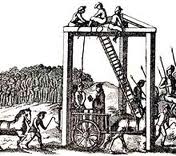Coming from London I wanted to share some of the best places to go if, like me, you are an early modern history nerd. Showing your parents around? Fear not, although a plaque on the floor/wall may be a bit of an anti-climax I have included pubs which have a link with the places so why not trick them into a history fest while getting lunch?
Tyburn Tree
Tyburn was the site of thousands of public executions and very significant for Catholicism in England. From 1571 the gallows became the ‘tree’ as it changed from its usual one bar gallows set up, which had been used there from around 1196, to a wooden triangle supported by three legs. This shape allowed more prisoners to be executed at the same time.
Tyburn was the site for around 105 Catholic martyrdoms, including the famous martyrdom of Edmund Campion.
You will find this rather disappointing marker on the traffic island at the junction of Edgware Road, Marble Arch and Oxford Street:
so your imagination will be very necessary.
If you need help imagining why not take extracts from Thomas Alfield’s A true reporte of the death & martyrdome of M. Campion Iesuite and preiste, & M. Sherwin, & M. Bryan preistes, at Tiborne the first of December 1581 Observid andwritten by a Catholike preist?
I suggest going to the Rose & Crown (2 Old Park Lane, W1K 1QN). Often prisoners heading for the gallows were incarcerated overnight here. It will also allow you to get into the spectator mind-set. Of course for some of the attendees executions were a solmn religious experience. They were the making of a saint and one could access God’s grace through these martyrs. The martyrs blood confirmed the ‘True Church’. However for some spectators this was like watching sport is today. The executions attracted thousands of viewers who would eat, drink and be merry.
More fun facts about the Rose & Crown:
This pub is around 400 years old and survived the Blitz completely undamaged. It is mentioned by Shakespeare in Henry VIII. Oliver Cromwell’s bodyguards used to stay here.
The Martyrs Journey
If you fancy a walk and a fun (o.k. also slightly macabre) way to see London why not retrace the martyrs last route?
The starting point would be Newgate prison where a lot of the Catholic prisoners were held. The prison was demolished in 1904 but the Central Criminal Court (also known as the Old Bailey) was built upon the site.
You need to travel from east to west, along Holborn, St Giles, and the Tyburn Road (now called Oxford Street). The gallows were near to the place we now know as Marble Arch. The saying ‘going west’ as a euphemism for execution comes from this.
***
The Anchor, Bankside
The Anchor dates back to 1615 and was a place to grab a beer or ale for Samuel Pepys, Dr Samuel Johnson and William Shakespeare, making it high up on the list for the early modern history lover. It is very close to the globe so maybe walk from there down? It may, this is a guess, but, a reasonable one, be close to the site that John Evelyn watched the fire of London from. Of course the sky line has changed dramatically, but why not print out a copy of the passage from Evelyn’s diary, sit outside (weather permitting) and grab a drink.
Link to a website containing both the Pepy’s entry and John Evelyn’s for the fire of London:
http://www.pepys.info/fire.html
***
Prince Henry’s Room, Inner Temple Gateway, Fleet Street
Well I can’t say it better than this:
http://medieval-london.blogspot.co.uk/2012/04/prince-henrys-room-inner-temple-gateway.html
***


